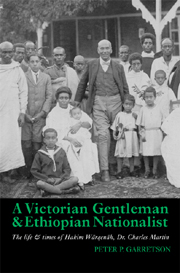 A Victorian Gentleman and Ethiopian Nationalist
A Victorian Gentleman and Ethiopian Nationalist Book contents
- Frontmatter
- Contents
- List of Illustrations
- Transliteration
- Note on the Ethiopian Calendar
- Glossary
- Acknowledgements
- Map 1 Ethiopia 1900–1950
- Map 2 Burma 1898–1919
- Introduction
- 1 Youth & education
- 2 Return to Ethiopia (1896–1901)
- 3 Campaigning in the Ogaden & return to Burma (1901–1907)
- 4 Transitions in life
- 5 A man of substance in Ethiopia & Burma
- 6 Return of a progressive to Addis Ababa (1919–1924)
- 7 An increased pace of modernization (1924–1930)
- 8 International diplomacy, education & recruitment
- 9 Governor of a model province, Chärchär (1930–1935)
- 10 Ethiopian ambassador to the Court of St. James (1935–1936)
- 11 London & India
- 12 Ethiopia
- Conclusion
- Bibliography
- Index
6 - Return of a progressive to Addis Ababa (1919–1924)
Published online by Cambridge University Press: 05 April 2013
- Frontmatter
- Contents
- List of Illustrations
- Transliteration
- Note on the Ethiopian Calendar
- Glossary
- Acknowledgements
- Map 1 Ethiopia 1900–1950
- Map 2 Burma 1898–1919
- Introduction
- 1 Youth & education
- 2 Return to Ethiopia (1896–1901)
- 3 Campaigning in the Ogaden & return to Burma (1901–1907)
- 4 Transitions in life
- 5 A man of substance in Ethiopia & Burma
- 6 Return of a progressive to Addis Ababa (1919–1924)
- 7 An increased pace of modernization (1924–1930)
- 8 International diplomacy, education & recruitment
- 9 Governor of a model province, Chärchär (1930–1935)
- 10 Ethiopian ambassador to the Court of St. James (1935–1936)
- 11 London & India
- 12 Ethiopia
- Conclusion
- Bibliography
- Index
Summary
Hakim Wärqenäh and Qätsälä's return to Ethiopia in 1919, which should have been a joyous occasion, turned out, to be a time of death, sickness and pain. While traveling home from Burma Wärqenäh was informed that Qätsälä's mother had died and upon arrival in Ethiopia that her father had also passed away. This must have been a devastating shock to them both. Their first few days and weeks back in Addis Ababa were filled with preparations for funerals and memorials but also a most symbolic act, the freeing of their family's slaves. Within a few months Wärqenäh himself became gravely ill with influenza and hovered near death. His recovery was slow, relapses occurred and it was not until April 1920, that he had fully recovered. The post-World War I Influenza Epidemic had hit his family very hard indeed.
All these shocks seem to have driven Wärqenäh, at the age of 54, to reevaluate his life and focus on what would be most important in guiding him through his remaining years. Four priorities came to the fore: first, the security of his ever growing family (and the paramountcy of giving his children a solid western education); second, leaving a permanent legacy by freeing the family's slaves; third, constructing permanent buildings in the form of bricks and mortar; and finally, focusing on reforming and modernizing Ethiopia, especially in the area of education. In the last months of 1919 and throughout most of the first half of 1920 his major priorities were to recover from illness and establish a home in Addis Ababa for his family.
- Type
- Chapter
- Information
- A Victorian Gentleman and Ethiopian NationalistThe Life and Times of Hakim Wärqenäh, Dr. Charles Martin, pp. 101 - 123Publisher: Boydell & BrewerPrint publication year: 2012


